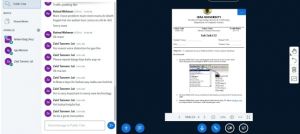Course overview
The objectives of the Human Computer Interaction course are to provide students with a broad view of both theoretical and practical issues in human factors for the design of human-computer interfaces, to equip students with knowledge and understanding of the nature of human computer interactions, human characteristics, computer systems, and interface architecture, and to equip students with sound skills in design, development, and evaluation of user interfaces.
Upon completion of the course students are able to:
- Understand and appreciate the human factors and the theoretical issues involved in human-computer interaction.
- Apply theoretical design principles to the design and evaluation of user interfaces.
- Collect user requirements, design a human-computer interfaces according to these requirements, and evaluate the design.


Participants in piloting
The Human Computer Interaction course is mandatory for 3rd year students in the BS in Computer Science, BS in Software Engineering, and BS in Information Technology programs. The Human Computer Interaction course involves 2 theoretical classes and a 3-hour laboratory session each week.
Use of ALIEN services and tools
The course was partially conducted physically and partially online due to an ongoing pandemic. Several topics were covered in theoretical lectures including interaction paradigms, interaction frameworks, interaction styles, interaction design process, conceptual design, physical design, evaluation, design principles, interaction design models, and usability testing. The laboratory sessions provided students with an opportunity to use the available equipment for the design, development of proof of concept prototypes, and the evaluation of prototypes by users or experts using the typical steps of design lifecycle, including requirements specification, designing alternatives, prototyping, and evaluating. For instance, as a part of the heuristic evaluation topic, students were asked to evaluate AR and VR applications using augmented and virtual reality design heuristics to identify the issues that need to be fixed in the application. In laboratory sessions, students were granted access to all the equipment available in the ALIEN Problem-Based Learning Laboratory.


